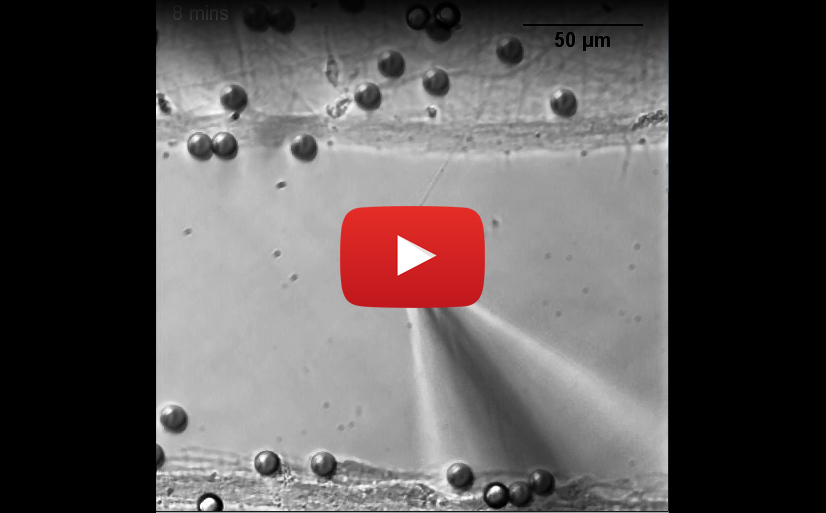Want to rewire a neuron? You’ve got to take it slow

By Katherine Gombay, McGill Newsroom
New technique offers potential to reconnect neurons of people with central nervous system damage
That very fine hair-line object that you see being pulled across the screen is actually a neuron being made. A research team led by McGill University and the Montreal Neurological Institute has managed to create new functional connections between neurons for the first time. Apart from the fact that these artificial neurons grow over 60 times faster than neurons naturally do, they are indistinguishable from ones that grow naturally in our bodies.
“It’s really very exciting, because the central nervous system doesn’t regenerate,” says Montserrat Lopez, a McGill post-doctoral fellow who spent four years developing, fine-tuning and testing the new technique. “What we’ve discovered should make it possible to develop new types of surgery and therapies for those with central nervous system damage or diseases.”
Caption: McGill researchers have been able to artificially create functional neurons that grow over 60 times faster that neurons do naturally. What you are seeing is the creation of a functional neuronal circuit, as part of a neuron attached to a small bead is gently stretched to connect with part of another neuron.
Rewiring a neuron takes some very careful moves
Because neurons are about the size of 1/100th of a single strand of hair, it takes some very specialized instruments and a lot of careful manipulation to create healthy neuronal connections that transmit electrical signals in the same way that naturally-grown neurons do.
The researchers used an atomic force microscope to attach a very small polystyrene ball (a few micrometers in size) to a portion of a neuron that acts as the transmitter, which they then stretched, a bit like pulling on a rubber band, to extend and connect with the part of the neuron that acts as a receiver.
“We would never have made this discovery if the people working in the lab hadn’t figured out that you had to avoid any quick or jerky movements when you move the newly-made neurons around,” says Peter Grutter, a McGill physics professor and the senior author on the paper that was published last week in the Journal of Neuroscience. “Until they found the right way to walk the neurons across the lab, from the microscope to the incubator where the newly-made neurons are left to grow for 24 hours, we weren’t having any luck getting them to behave the way we wanted them to.”

Figure 1 Mechanically pulled connection between two neurons. Left: before, right: after manipulation
Sometimes letting go can be hard to do
An even bigger challenge than getting the neurons to connect in the proper way, proved to be getting the newly-formed neurons to detach from the tool that had been used to create them without being destroyed in the process. Eventually, the researchers figured out how to sever the connection and still preserve the functional neuron by releasing the beads.
Although it is now possible to create new neuronal connections, there is still much work ahead.
“The neurons we were able to create were just under 1mm long, but that’s because we were limited by the size of the dish we used,” says Margaret Magdesian, a neuroscientist who is the first author on the paper, and who worked at the Montreal Neurological Institute when the research was done. ”This technique can potentially create neurons that are several mms long, but clearly more studies will need to be done to understand whether and how these micro-manipulated connections differ from natural ones.”
To read “Rapid Mechanically Controlled Rewiring of Neuronal Circuits” by M.H. Magdesian et al in the Journal of Neuroscience: doi:10.1523/JNEUROSCI.1667-15.2016
Financial support for the research was provided by the Natural Sciences and Engineering Research Council of Canada (NSERC) Discovery Grant, McGill University, James McGill research stipend, Le regroupement québécois sur les
matériaux de pointe—Fond de recherche du Québec—Nature et technologies, Canadian Institutes of Health ResearchTraining Grant, and NSERC Collaborative Research and Training Experience.


